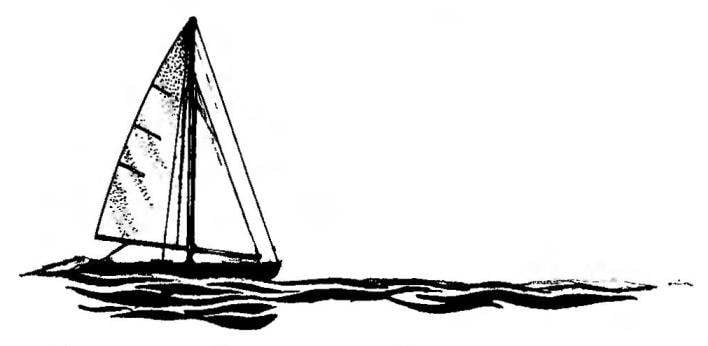The easiest way to cast him “into the ground” — in sand-clay the form obtained by pressing it to the plane of symmetry of the model Bulba, carved out of wood. Bulbs obtained from pairs of such castings, tied in a single whole with three or four screws-tapping screws.
The next stage of construction of the body — bonding of the frame members and the keel well, which under the wooden slats, plywood box and pitching well in the foam cut grooves, and all these details are fixed in the housing with epoxy glue.
The thus prepared body finally barked and glued by epoxy resin with two or three layers of thin fiberglass or nylon (nylon stocking). After resin curing, the hull puttied, barked at him pasted Stasova strap, hinge joint helm, forestay and vant-potency, and its surface is painted with automotive paint.
RC model yachts:
1 — forestay-potens; 2,8,15 — booty; 3 — the jib boom (pine, battens 5×5); 4 — the jib sheet (nylon thread); 5 — staysail (synthetic cloth or Mylar film); 6 — forestay (nylon thread); 7 — guy (nylon thread); 9 — end kriplennya guys and the forestay; 10 — plate; 11 — left vant-potens; 12 grotto (a synthetic cloth or Mylar film); 13 — the mainsail (pine, rack 5×5); 14.25 — tensioner arm (duralumin, sheet s1); 16 — the geek sheet (nylon thread); 17 — Kip; 18 — the rocking of the shaft; 19 — steering pen (aluminum, sheet s4); 20 Kil (duralumin, sheet s6); 21 — Stasova strap (made of anodized aluminum, sheet s); 22 — palpal bulb (lead weight of about 900 g); 23 — rocking the steering machine; 24 — cover of the radio (plywood s4); 26 — mast
The theoretical drawing of the hull yacht model
The design of the hull model:
1,16 — gerianne frame elements (pine, rail 30х10); 2 — Stasova strap (made of anodized aluminum, sheet 53); 3 — Kip staysail-sheet; 4 — mast (pine, rail 12×12); 5 — spurs of the mast (steel wire d3); 6 — M4 screw mounting of the keel; 7 — tension strap (made of anodized aluminum, sheet s1); 8 — guys-Putins (duralumin, sheet 51); 9 — the bottom of the radio compartment (plywood s3); 10 — cover radio equipment (plywood s4); 11 —”area” (pine, rail 20×20); 12 — the cage radio (plywood s3); 13 — base of the case (foam PS-4-40 or packaging); 14 Kil (duralumin, sheet s6); 15 — the well of the keel (Vileika of fiberglass and epoxy resin); 17 — the guy (nylon thread); 18 — M3 screw of fastening of a cover of the hatch
The principal dimensions of the sails of model yachts (1 mainsail, 2 headsail):
AB=1290; AC=1240; BC=460; DF=1050; DE=950; EF=360
The mast, representing a truncated cone, cut from high-quality pine slats — the bigger its diameter is 12 mm, lower 6 mm. At the top of the mast fixed fittings of cut copper tube 5×0,5 mm. In three bent legs of the ferrules drilled holes with a diameter of 1 mm for fastening of for-forestay and guys.
The mast is fixed on the chassis by a pair of guys and of for-stays. These elements of standing rigging standing;!?, yut pieces of durable synthetic yarn or fishing line; their upper ends are attached by hinges and the lower are placed on a special stretch straps — dural strips with drilled holes.
The sails are cut out of thin windproof synthetic fabric (this usually is used to make jackets jackets). However, sails can be made from Mylar film. When cutting the grotto it is necessary to provide allowance for mast pocket (its width in the lower part of the sail — 40 mm, top — 20 mm) and advertka bottom and back edges. By the way, the trailing edge is supported by three armor — plastic plates, placed in sewn on the sail laderman.
Debugging the yacht’s sailing qualities is recommended in unmanaged mode. The important thing is to ensure the coincidence of the center of lateral resistance of the hull and the centre of sail — the yacht is not given to wind and not uvarivaetsja under it. This is likely to require adjustment of the mast — it would have to move in another hole on stepsaway plate. In the small confines of the center of the sail can be changed by dragging the shrouds and forestay and moving the mast forward or backward. The proper model is capable of automatically maintain a course relative to the wind direction.
Install the receiver and steering servos do not require any changes to the system of the yacht. The proposed model focused only on the steering gear.
I. TEREKHOV
Recommend to read LET THE WIND The wind has always been a symbol of impermanence, and attempts to transform its energy into electrical energy has led often to results that are not very encouraging. Indeed, everything... AMPHIBIAN ON BED We present a prototype of the amphibious machine is a device hovercraft (Ohr) under the name "Aerodzhip", publication of which was in the journal "modelist-Konstruktor" No. 7 for 2007.... 

